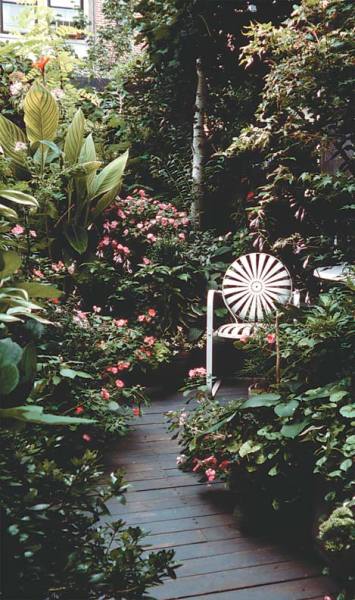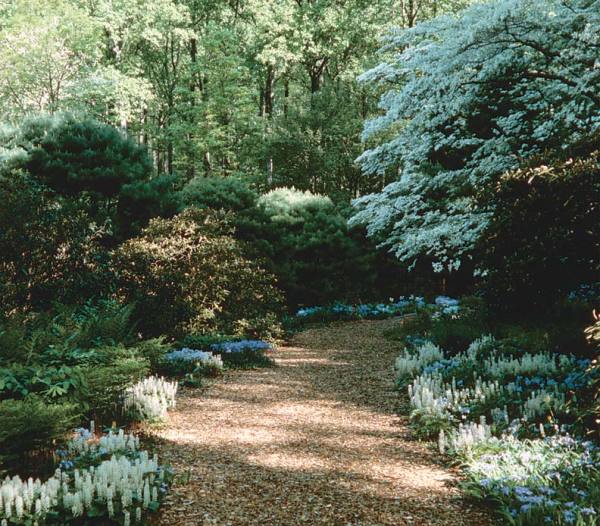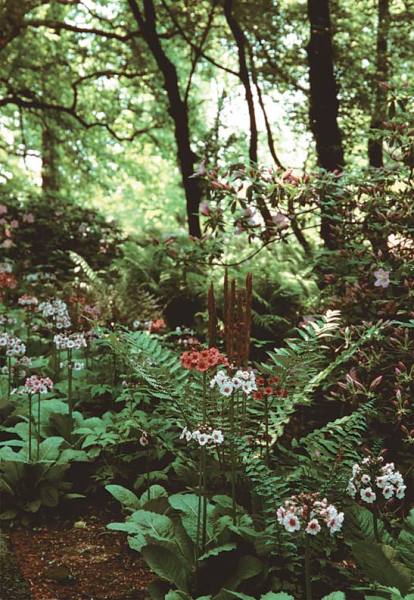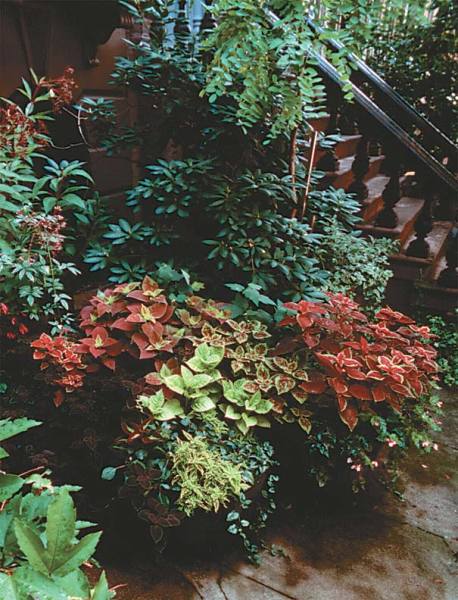
The lush environment of a shady city courtyard is enlivened by impatiens and both striped and variegated hosta.
Photos by Ken Druse
The Victorians had the right idea. On hot summer days, they retreated to chairs and benches under a leafy canopy of spreading trees, surrounded by a living room filled with cooling ferns, shrubs, vines, and wildflowers. Come high summer, when sweltering heat and humidity are enough to wilt most gardeners, the shade garden continues to offer a welcome respite. With its dappled sunlight and morning dew, the shaded nook is a delightful place where gardeners can focus on plants that thrive on limited amounts of light.
Unlike their showy counterparts—zinnias, day lilies, and roses—the unusual, variegated foliage of shade-loving plants offers a display of muted greens and blues that lasts longer than many flowers. Shady gardens are often a fact of life for those who dwell in old houses, from residents of urban row houses with courtyards cast into deep shade, to the owners of venerable homes enfolded by mature trees and shrubs.
While some folks lament the fact that they must garden in the shade of towering trees or nearby buildings, others recognize the wonderful possibilities such sites offer. The Victorians, for instance, were so fond of ferns that they created ferneries—collections of lacy, delicate-leafed fern specimens—that thrived in shady spots near the house. Similarly, in the early years of the 20th century, trellises, loggias, and pergolas were a favorite means of establishing shady spots to the rear or side of an Arts & Crafts bungalow or Colonial Revival home.
If your house is blessed with an abundance of shade, bear in mind that not all shade is equal. Shade varies in degree from partial (or open) shade to full (or dense) shade. When tall trees allow a great deal of bright light to reach the ground, the result is partial shade. Walls, fences, and other solid structures in close proximity to the garden tend to create full shade.

Blue iris, blue phlox, and foamflower edge a path leading into the woods.
While full sun generally means six hours or more of direct sun each day, partial shade provides direct sun for only three or four hours. Plants in full shade get bright, reflected light, but little or no direct sun. Paying close attention to where the summer sun crosses your property at midday will help you determine how much shade you have.
Mature trees with large, spreading crowns—maple, oak, hickory, and elm, for example—are the dowagers of the shade garden. Trees with finely textured leaves, like honey locust and the silk tree, send more dappled light to the ground than the dense canopies of sugar maples.
If you are starting from scratch and your garden has space for a shade tree, select one that grows well in your locale. Medium-sized ornamental trees, such as dogwood or serviceberry, provide a suitable canopy for smaller sites. You can also create a shade-garden version of a forest understory with small- to medium-size shrubs, such as stephenandra, viburnum, variegated dogwood, or holly. An arbor, loggia, pergola, or high fence can create shade when there is no room for trees or large shrubs.

Primula and ferns grace a cool forest floor.
Where adjacent structures shade urban gardens, cloak the walls in vines that thrive in limited light. Choose from climbing hydrangea, with its fragrant white flowers and peeling bark, or old standbys such as English or Boston ivy, or Virginia creeper. Some flowering vines, including silver lace vine and a few varieties of clematis, will take more shade than other climbers—although they produce fewer flowers than when in full sun. In small urban gardens, you can prune a large shrub such as witch hazel, pagoda dogwood, or Japanese maple to resemble a small tree with an arching canopy.
For smaller gardens or shady side yards, use a combination of unusual plants rather than just one or two species. For instance, the delicate, showy stems of corydalis mix well with native bleeding heart, shooting stars, or miniature hosta. In moist areas, add a splash of red with scarlet lobelia or coral bell—both favorites with hummingbirds.
Create visual interest by combining plants with contrasting leaf forms. For example, the delicate fronds of the maidenhair fern pair nicely with the coarse leaves of pachysandra, a groundcover. The large blue crenellated leaves of the fragrant, flowering heirloom hosta ‘Elegans’ contrast well with the soft delicate sprays of astilbe flowers.
Think of the shade garden as a small forest complete with a carpet of groundcovers such as periwinkle, hosta, epimedium, and ivy. The white- and silver-splashed leaves of lungwort and lamium ‘White Nancy’ light up a shady spot, as will hostas with variegated or chartreuse leaves. The shade garden is a restful place where the tracery of shadows, whether from trees or man-made structures, makes for an interesting play of light on your own private forest floor.
Tips for the Shade Garden

Foliage in an array of colors and textures makes a diverse showing by the steps of a brownstone.
- Other than moss, few plants will grow in very deep shade. In places where no direct sunlight reaches the garden, you can paint nearby fences or walls white to reflect all available light.
- To increase the amount of light reaching your garden, consider “limbing up” a tree. Use a long-handled pruning tool (available at garden and home supply centers) to thin lower limbs or inner branches.
- Plant carefully beneath a mature tree. Poking too many holes near the base may disturb the tree’s shallow root system. Instead, mulch the entire area with shredded wood chips to conserve moisture and help keep weeds to a minimum. Gradually add groundcovers underneath the tree’s outermost branches.
- Ferns, iris, and other shade-loving plants need plenty of moisture. If rainfall drops below 1 per week in summer, water your plants regularly.
- Few shrubs require full sun to thrive, but many will do well in full shade. The deeper the shade, however, the more difficult it is to grow plants that prefer full or partial sun.
- Plant spring-flowering bulbs, such as daffodils, under trees where they will bloom before the trees leaf out. Intermingle them with hosta, which will conceal the leaves in midsummer.
- Add native woodland wildflowers, such as bluebells, trillium, or Solomon’s Seal, to a shade garden.
- For a low-maintenance garden, use shade-tolerant groundcovers and perennials and incorporate a few annuals—impatiens or tuberous begonias—for spots of color.
- Adding a birdbath or fountain to your shady retreat will bring wildlife up close. And, like the Victorians, furnish your leafy outdoor room with a bench or chairs for full enjoyment.







